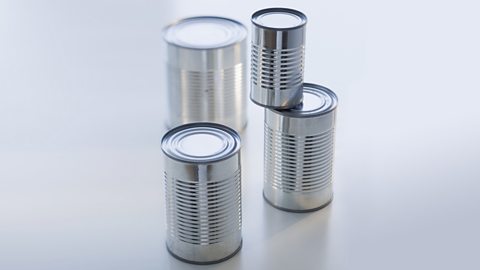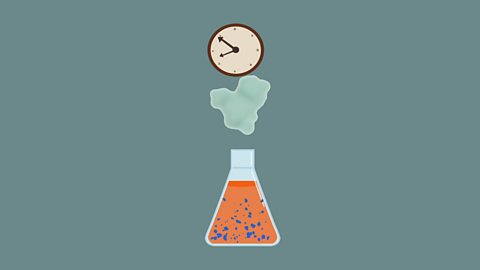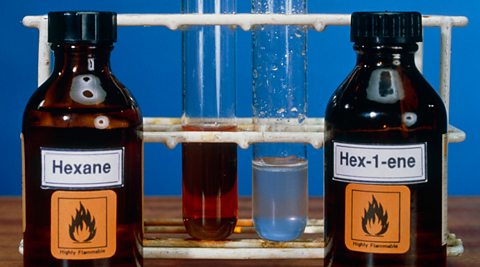What are the key learning points?
The reactivity series is a list that shows the order of reactivity of metals. The metals are ordered by comparing the observations of their reactions with oxygen, water and steam.
A more reactive metal can displace a less reactive metal from its compoundA substance formed when two or more elements are chemically combined. in a displacement reaction.
Metals can be extracted from oreA rock that contains enough of a metal or a metal compound to make extracting it economically worthwhile. in the ground, and the method used depends on the reactivity of the metal.
What is the reactivity series of metals?
The reactivity series is a list that shows the order of reactivity of some common metals.
In general, the more reactive a metal is:
- the more vigorously it reacts with other substances; and
- the more easily it loses electronSubatomic particle, with a negative charge and a very small mass relative to protons and neutrons. to form positive ionElectrically charged particle, formed when an atom gains or loses electrons.(cations)
We can examine the reactivity of metals by observing their reactions with oxygen, water, steam and whether it displaces other metals in displacement reactions.
Prescribed practical C5: Investigate the reactivity of metals
Please use the link below to access the article on: Prescribed practical (C5) - Investigate the reactivity of metals
How do metals react with oxygen?
Many metals react with oxygen to form metal oxides in the following reaction:
metal + oxygen → metal oxide
The following apparatus is used to react metals with oxygen in a laboratory.
The following observations are made for the reactions of the metals of the reactivity series with oxygen:
| Metal | Reaction with oxygen | Equation |
|---|---|---|
| Potassium (K) | Reacts vigorous when heated. Lilac flame observed and white solid formed. | 4K + O2 → 2K2O |
| Sodium (Na) | Reacts vigorously when heated. Yellow/orange flame observed and white solid formed. | 4Na + O2 → 2Na2O |
| Calcium (Ca) | Reacts vigorously with strong heating. Brick red flame observed and white solid formed. | 2Ca + O2 → 2CaO |
| Magnesium (Mg) | Reacts readily with strong heating. White light observed and white solid formed. | 2Mg + O2 → 2MgO |
| Aluminium (Al) | Reacts readily with strong heating as a powder. White solid formed. | 4Al + 3O2 → 2Al2O3 |
| Zinc (Zn) | Reacts steadily when heated forming a yellow solid which changes to white on cooling. | 2Zn + O2 → 2ZnO |
| Iron (Fe) | Reacts readily when heated as iron filings. Orange sparks observed and black solid formed. | 3Fe + 2O2 → Fe3O4 |
| Copper(Cu) | Reacts on heating to form a black solid. | 2Cu + O2 → 2CuO |
Potassium and sodium are soft metals which are easily cut exposing a shiny surface which becomes dull rapidly.
The change from shiny to dull is called tarnishing.
The less reactive metals tarnish over a longer period of time.
How do metals react with water?
When a metal reacts with water, a metal hydroxide and hydrogen are formed.
metal + water → metal hydroxide + hydrogen
Potassium and sodium react very vigorously with water.
A small piece of these metals is dropped into a large trough of water behind a safety screen.
Tweezers/tongs are used to hold the piece of metal to avoid harmful contact with the skin.
The apparatus below is used to react calcium with water and collect the gas.
This would not be used with sodium or potassium as the reaction is too vigorous.
The following observations are made for the reactions of the metals of the reactivity series with water:
| Metal | Reaction with water | Equation |
|---|---|---|
| Potassium (K) | Reacts vigorously. Floats on the surface. Moves and fizzes. Burns with a lilac flame. Heat is released. Crackle as it disappears. Colourless solution remains. | 2K + 2H2O → 2KOH + H2 |
| Sodium (Na) | Reacts vigorously. Floats on the surface. Moves and fizzes. Melts to form a silvery ball. Heat is released. Crackle as it disappears. Colourless solution remains. | 2Na + 2H2O → 2NaOH + H2 |
| Calcium (Ca) | Reacts readily. Fizzes. Grey solid sinks then rises. Heat is released. Grey solid disappears. Solution appears milky. | Ca + 2H2O → Ca(OH)2 + H2 |
| Magnesium (Mg) | Very slow reaction. A few bubbles of gas produced. | Mg + 2H2O → Mg(OH)2 + H2 |
| Aluminium (Al) | No reaction | - |
| Zinc (Zn) | No reaction | - |
| Iron (Fe) | No reaction | - |
| Copper(Cu) | No reaction | - |
Only the four most reactive metals of the reactivity series react with water.
Aluminium is unusual, because it is a reactive metal that does not react with water.
The surface of aluminium forms a protective layer of aluminium oxide that keeps water away from the metal below.
How do metals react with steam?
Some metals that do not react with water can be reacted with steam due to the increased temperature of the reaction.
Metals that react with steam form a metal oxide and hydrogen gas.
metal + steam → metal oxide + hydrogen
The apparatus used to react a metal with steam and collect the gas produced is shown below.
The following observations are made for the reactions of the metals of the reactivity series with steam:
| Metal | Reaction with steam | Equation |
|---|---|---|
| Potassium (K) | Too dangerous to be attempted. | - |
| Sodium (Na) | Too dangerous to be attempted. | - |
| Calcium (Ca) | Too dangerous to be attempted. | - |
| Magnesium (Mg) | Reacts on strong heating. Bright white light observed and white solid formed. | Mg + H2O → MgO + H2 |
| Aluminium (Al) | Reacts as a powder on strong heating. White solid formed. | 2Al + 3H2O → Al2O3 + 3H2 |
| Zinc (Zn) | Reacts as a powder on strong heating. Yellow solid forms which changes to white on cooling. | Zn + H2O → ZnO + H2 |
| Iron (Fe) | Reacts as a powder on very strong heating. Black solid formed. | 3Fe + 4H2O → Fe3O4 + 4H2 |
| Copper(Cu) | No reaction. | - |
What are displacement reactions?
More reactive metals displace less reactive metals from their compoundA substance formed when two or more elements are chemically combined..
For example, magnesium is more reactive than copper.
It displaces copper from copper(II) sulfate solution.
magnesium + copper(II) sulfate → magnesium sulfate + copper
Mg(s) + CuSO4(aq) → MgSO4(aq) + Cu(s)
In this displacement reaction, the following observations are made:
- The grey magnesium gradually disappears, and red-brown copper is formed.
- The solution’s blue colour fades as blue copper(II) sulfate is replaced by colourless magnesium sulfate solution.
- Heat is released.
You can work out a reactivity series for metals by carrying out displacement reactionA reaction in which a more reactive metal takes the place of a less reactive metal in a compound..
The table below shows the results of reacting different metals with different metal compound solutions.
| Magnesium sulfate solution | Copper(II) sulfate solution | Iron(II) sulfate solution | Number of reactions | |
|---|---|---|---|---|
| Magnesium | Not done | Brown coating | Black coating | 2 |
| Copper | No visible reaction | Not done | No visible reaction | 0 |
| Iron | No visible reaction | Brown coating | Not done | 1 |
Magnesium is the most reactive metal from these three as it undergoes two reactions, iron is next and copper is the least reactive.
Question
A number of displacement reactions were carried out with four metals and four metal compounds.
The results are shown below – a tick (✔) indicates that a reaction took place and a cross (✘) indicates a reaction did not take place.
| Zinc sulfate | Tin sulfate | Copper(II) sulfate | Iron(II) sulfate | |
|---|---|---|---|---|
| Zinc | - | ✔ | ✔ | ✔ |
| Tin | ✘ | - | ✔ | ✘ |
| Copper | ✘ | ✘ | - | ✘ |
| Iron | ✘ | ✔ | ✔ | - |
Order the metals from most reactive to least reactive.
Ionic equations
Here is the balanced ionic equationA chemical equation that shows how positively charged ions join with negatively charged ions to make a compound. for the reaction between magnesium and copper(II) sulfate.
The equation below shows the ions present on both sides of the equation:
Mg(s) + Cu2++(aq) + SO42-(aq) → Mg2+(aq) + SO42-(aq) + Cu(s)
Sulfate ions, SO42- , appear on both sides of the equation because they do not take part in the reaction.
The ionic equation for the reaction is written without sulfate ions:
Mg(s) + Cu2+(aq) → Mg2+(aq) + Cu(s)
How are metals extracted from ores?
What are ores?
Some metals, typically the unreactive ones like gold, are found in the Earth’s crust as pureA pure substance is a single element or compound not mixed with any other substance. elements.
But most metals are found combined with other elements to form compoundA substance formed when two or more elements are chemically combined..
These compounds are mixed in with other types of rock.
Key fact
An ore is a rock that contains enough of a metal or a metal compound to make extracting it economically worthwhile.
What are the different methods used to extract metals?
Metals are extracted from their ores using different methods depending on their position in the reactivity series.
electrolysisSplitting up a liquid or dissolved compound into its elements using electricity. of molten compounds is used to extract the most reactive metals.
In principle, all metals can be extracted using electrolysis but it is expensive.
If a metal is less reactive than carbon, it is cheaper to extract it by heating with carbon or carbon monoxide.
The very least reactive metals, such as gold, occur as pure elements, but may be contaminated with other elements.
They are cleaned through various chemical reactions.
What is phytomining (Higher tier only)
Phytomining is a process where plants can be used to absorb metal ionElectrically charged particle, formed when an atom gains or loses electrons. from ground through their roots.
This can be used to extract metals like copper from soil.
Plants are used to absorb metal compounds such as copper(II) compounds.
The plants are harvested, then burned to produce ash, which contains the metal compounds.
An acid (often sulfuric acid) is added to the ash to produce a solution containing dissolved metal compounds (leachate).
Copper can be obtained from these solutionA mixture made when a solute (usually a solid) dissolves into a solvent (a liquid). Sea water is a solution of salt dissolved into water. by displacement reactionA reaction in which a more reactive metal takes the place of a less reactive metal in a compound.using scrap iron.
Phytomining is slow, but it:
- reduces the need to obtain new oreA rock that contains enough of a metal or a metal compound to make extracting it economically worthwhile. by mining. Mining has a negative environmental impact through noise and dust pollution.
- conserves limited supplies of more valuable ores with higher metal content.
How much do you know about metals and the reactivity series?
More on Unit 2: Further chemical reactions, rates and equilibrium, calculations and organic chemistry
Find out more by working through a topic
- count2 of 9

- count3 of 9

- count4 of 9

- count5 of 9
